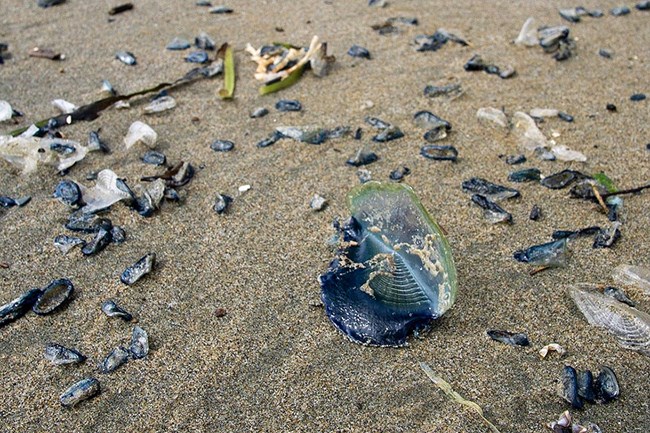
NPS / Anela Kopshever As you walk along the beach during the spring or early summer months, you may see scores of blue or clear. objects washed up on the sand. These jellyfish-like creatures are called Velella velella, or "by-the-wind-sailors." Velella are not true jellyfish, but are related to jellyfish, as well as to sea anemones, corals, and hydroids. The Velella is a flat, oval-shaped creature, bluish to purple in color and three to four inches long. The body is relatively firm and has a flexible two-inch-high triangular "sail" attached to it. The Velella's sail is S-shaped at its base and is attached to the body diagonally. Dangling from its body are numerous blue tentacles which contain stinging cells (cnidocysts, also called nematocysts) to help capture the Velella's food. Velella's stinging cells are rarely harmful to humans, as opposed to those of the Portuguese man o' war. Velella is an off-shore animal which lives on the surface of the water. It feeds on planktonic crustaceans, primarily copepods. Known predators are limited, but include nudibranchs (sea slugs) in the genus Glaucus and purple snails in the genus Janthina. The name "by-the-wind-sailor" is really a misnomer for this little animal. Velella don't actively navigate using their sail, although they are at the mercy of the winds as to where they go. When the sail catches the wind, the Velella will be blown downwind at an angle to the wind. This sets Velella apart from many other jellyfish, which drift with the ocean currents. Some sails on Velella angle to the left and propel the animal left of downwind; others angle to the right and propel the animal right of downwind. Due to the prevailing winds in different parts of the world, left-handed Velella are usually found·in the Northern Hemisphere, while right-handed ones are usually found in the Southern Hemisphere. When the prevailing winds shift, such as during a storm, the Velella are driven towards the coast, where they often are stranded on beaches in great numbers. As the Velella dries out on the beach, it becomes brittle and transparent, looking like a cellophane candy wrapper. Velella are one of the few examples of the high seas life which beachcombers may find in Point Reyes National Seashore. |
Last updated: December 29, 2022
